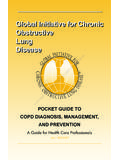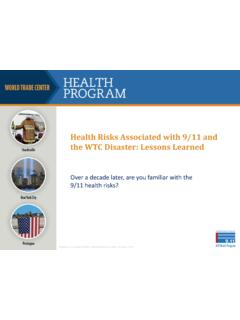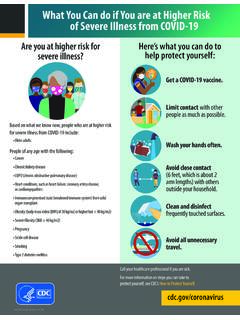Transcription of 21072 WHS 2021
1 202120212021 World health Statistics 2021 The World health statistics report is the World health Organization s (WHO) annual compilation of the most recent available data on health and health -related indicators for its 194 Member States. The 2021 edition features the latest data for 50+ health -related indicators from the Sustainable Development Goals (SDG) and WHO Triple Billion targets. The 2021 report additionally focuses on the human toll and impact of the coronavirus disease 2019 (COVID-19) pandemic, highlighting the importance of tracking inequalities and the urgency to accelerate progress to get back on track and recover equitably with the support of robust data and health information health statistics 2021: monitoring health for the SDGs, sustainable development goalsISBN 978-92-4-002705-3 (electronic version) ISBN 978-92-4-002706-0 (print version) World health Organization 2021 Some rights reserved.
2 This work is available under the Creative Commons Attribution-NonCommercial-ShareAlike IGO licence (CC BY-NC-SA IGO; ). Under the terms of this licence, you may copy, redistribute and adapt the work for non-commercial purposes, provided the work is appropriately cited, as indicated below. In any use of this work, there should be no suggestion that WHO endorses any specific organization, products or services. The use of the WHO logo is not permitted. If you adapt the work, then you must license your work under the same or equivalent Creative Commons licence. If you create a translation of this work, you should add the following disclaimer along with the suggested citation: This translation was not created by the World health Organization (WHO).
3 WHO is not responsible for the content or accuracy of this translation. The original English edition shall be the binding and authentic edition . Any mediation relating to disputes arising under the licence shall be conducted in accordance with the mediation rules of the World Intellectual Property Organization ( ).Suggested citation. World health statistics 2021: monitoring health for the SDGs, sustainable development goals. Geneva: World health Organization; 2021. Licence: CC BY-NC-SA (CIP) data. CIP data are available at , rights and licensing. To purchase WHO publications, see To submit requests for commercial use and queries on rights and licensing, see Third-party materials.
4 If you wish to reuse material from this work that is attributed to a third party, such as tables, figures or images, it is your responsibility to determine whether permission is needed for that reuse and to obtain permission from the copyright holder. The risk of claims resulting from infringement of any third-party-owned component in the work rests solely with the disclaimers. The designations employed and the presentation of the material in this publication do not imply the expression of any opinion whatsoever on the part of WHO concerning the legal status of any country, territory, city or area or of its authorities, or concerning the delimitation of its frontiers or boundaries.
5 Dotted and dashed lines on maps represent approximate border lines for which there may not yet be full mention of specific companies or of certain manufacturers products does not imply that they are endorsed or recommended by WHO in preference to others of a similar nature that are not mentioned. Errors and omissions excepted, the names of proprietary products are distinguished by initial capital reasonable precautions have been taken by WHO to verify the information contained in this publication. However, the published material is being distributed without warranty of any kind, either expressed or implied.
6 The responsibility for the interpretation and use of the material lies with the reader. In no event shall WHO be liable for damages arising from its use. Printed in health FOR THE SDGsCONTENTSF oreword ..ivAbbreviations and acronyms ..vIntroduction ..viiKey messages ..viii1. The impact of COVID-19 on population health ..12. Healthy life expectancy and burden of disease ..163. Risks to health ..354. Universal health coverage ..465. Accelerating progress towards health -related SDGs and Triple Billion targets ..58 Annex 1. Regional highlights ..66 Annex 2.
7 Country, WHO region and global statistics ..81 Annex 3. List of countries by WHO regions ..117 Annex 4. Availability of disaggregated data for GPW 13 outcome indicators ..118ivWORLD health STATISTICS 2021 FOREWORDWhen the World health statistics was released last year, we were still in the early stages of the COVID-19 pandemic. Countries were responding rapidly under uncertain conditions, frontline health workers were making heroic efforts to contain the spread of the virus, and governments and partners were scrambling to assist those in year on, the world has made great strides.
8 But the race against this coronavirus and its variants is still on, and there is still much work to be done. At the time of writing, more than 160 million confirmed COVID-19 cases and million deaths had been reported to WHO. Yet these numbers are only a partial picture, as many countries have not been able to accurately measure and report on deaths that are either directly or indirectly attributable to COVID-19. One of the greatest lessons from the pandemic is the importance of timely, reliable, actionable and disaggregated data. This requires strong country data and health information systems through collaboration between governments, ministries of health , national statistical offices and registrar generals.
9 It also requires engagement with the private sector, academia, nonprofit organizations, and the scientific community to ensure data is accessible as a public s World health statistics report 2021 presents the latest data for more than 50 health -related indicators for the Sustainable Development Goals and WHO s Triple Billion targets. It finds an overall increase in global life expectancy and healthy life expectancy at birth as a result of improvements in several communicable diseases, maternal, perinatal and nutritional conditions, noncommunicable diseases, injuries and their underlying determinants.
10 Persisting inequalities also continue to impact population health in most, if not all, aspects. Despite the overall improvement in service coverage, between and within countries disadvantaged populations still have lower access to care and are at greater risk of facing catastrophic costs. While premature deaths from noncommunicable diseases the world s leading cause of death continue to fall, progress has slowed in recent years and key risk factors including tobacco use and alcohol consumption, hypertension, obesity and physical inactivity will require urgent and targeted intervention.















